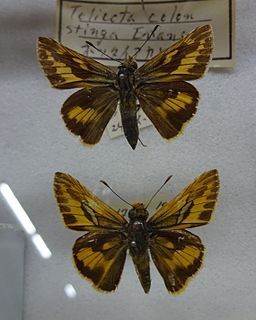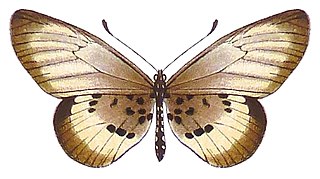
Apamea crenata, known as the clouded-bordered brindle, is a moth in the family Noctuidae. It is distributed throughout the Palearctic realm. In the North it crosses the Arctic Circle, in the Mediterranean it is found only in cool locations and mountains avoiding very hot areas. In the Alps, it rises to an altitude of about 2000 metres.

Telicota colon, commonly known as the pale palm dart or common palm dart, is a butterfly belonging to the family Hesperiidae found in India to Australia.

Azanus ubaldus, the bright babul blue, desert babul blue, or velvet-spotted blue, is a small butterfly found in India, the Middle East and Africa that belongs to the lycaenids or blues family.

Jamides celeno, the common cerulean, is a small butterfly found in Indomalayan realm belonging to the lycaenids or blues family. The species was first described by Pieter Cramer in 1775.

Kaniska canace, the blue admiral, is a nymphalid butterfly, the only species of the genus Kaniska. It is found in south and southeast Asia.

Ionolyce helicon, the pointed lineblue, or bronze lineblue, is a small butterfly found in the Indomalayan realm that belongs to the lycaenids or blues family.

Cataclysta lemnata, the small china-mark, is a moth species of the family Crambidae. It is found in Europe, Morocco and Iran.

Zeltus is a butterfly genus in the family Lycaenidae, the blues. It is monotypic containing the species Zeltus amasa, the fluffy tit, a small butterfly found in Indomalayan realm. The butterfly is found in India, specially the Western Ghats, Sikkim to Assam. It can also be found in Myanmar, Thailand, West Malaysia, Sumatra, Borneo, Java and the Philippines.

Mesapamea secalis, the common rustic, is a moth of the family Noctuidae. The species was first described by Carl Linnaeus in his 1758 10th edition of Systema Naturae. It is found in Europe, north-west Africa, Turkey and northern Iran.

Catochrysops strabo, the forget-me-not, is a small butterfly found in Asia that belongs to the lycaenids or blues family. The species was first described by Johan Christian Fabricius in 1793. It is found in Sri Lanka, India, from Sikkim to Indochina and in Sundaland, Sulawesi and the Philippines.
Hellinsia iobates is a moth of the family Pterophoridae that is found in the U.S. state of Arizona. The species was first described by William Barnes and Arthur Ward Lindsey in 1921.

Acraea peneleos, the Peneleos acraea, is a butterfly in the family Nymphalidae, which is native to the tropics and northern subtropics of sub-Saharan Africa.
Mimudea punctiferalis is a moth in the family Crambidae. It was described by South in 1901. It is found in China.
Pycnarmon peruvialis is a moth in the family Crambidae. It was described by George Hampson in 1917 and it is found in Peru.
Udea montanalis is a moth in the family Crambidae. It was described by Schaus in 1912. It is found in Costa Rica.
Ambia fulvicolor is a moth in the family Crambidae. It was described by George Hampson in 1917 and it is found in New Guinea.
Stenoma platyterma is a moth of the family Depressariidae. It is found in Guyana.
Paraspastis circographa is a moth of the family Depressariidae and the only species in the genus Paraspastis. It is found in Guyana.
Antaeotricha bicolor is a species of moth of the family Depressariidae. It is found in Brazil.
Pectinimura gilvicostata is a moth in the family Lecithoceridae. It is found in Papua New Guinea.









